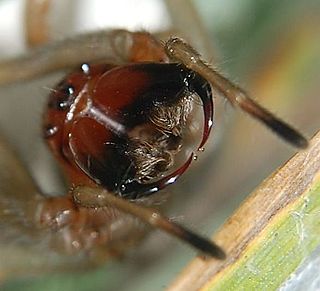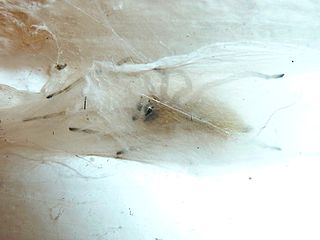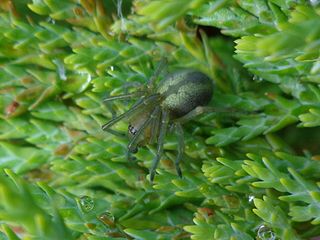
The Araneomorphae are an infraorder of spiders. They are distinguished by having chelicerae (fangs) that point diagonally forward and cross in a pinching action, in contrast to the Mygalomorphae, where they point straight down. Most of the spiders that people encounter in daily life belong to the Araneomorphae.

Cheiracanthium, commonly called yellow sac spiders, is a genus of araneomorph spiders in the family Cheiracanthiidae, and was first described by Carl Ludwig Koch in 1839. They are usually pale in colour, and have an abdomen that can range from yellow to beige. Both sexes range in size from 5 to 10 millimetres. They are unique among common house spiders because their tarsi do not point either outward, like members of Tegenaria, or inward, like members of Araneus), making them easier to identify. The name is a reference to the backwardly directed process on the cymbium of the male palp. The species epithet is derived from the Greek Ancient Greek: χείρ, romanized: cheir, meaning "hand", and Acanthium, a genus of thorny-stemmed plants.

Cheiracanthium punctorium, one of several species commonly known as the yellow sac spider, is a spider found from central Europe to Central Asia. They reach a length of about 15 mm, and their bite can penetrate human skin; the bite has been compared to a wasp sting, perhaps a bit more severe, although susceptible persons can have stronger reactions, like nausea. Females build an egg sac of about 4 cm in high grass. It opens below and is aggressively defended.
Cheiracanthium elegans is a species of spider in the genus Cheiracanthium found in Europe and Central Asia.

Cheiracanthium mildei is a species of spider from the family Cheiracanthiidae. C. mildei is commonly known as the northern yellow sac spider, a name it partially shares with many other spiders of its genus.
Cheiracanthium algarvense is a spider species found in Portugal and Spain.
Cheiracanthium is a spider species found in France.

Cheiracanthium furculatum is a spider species found in the Cape Verde Islands, mainland Africa, and the Comoro Islands. It has also been introduced into Belgium.
Cheiracanthium ienisteai is a spider species found in Albania and Romania.
Cheiracanthium insulare is a spider species found in Madagascar and Réunion.
Cheiracanthium macedonicum is a spider species found in Bulgaria and North Macedonia.
Cheiracanthium pennatum is a spider species found in Europe.

Cheiracanthiidae is a family of araneomorph spiders first described by Vladimir Wagner in 1887. The synonym Eutichuridae was used for a long time, but Cheiracanthiidae has priority. The largest genus currently recognized as belonging to this family is Cheiracanthium, which has previously been placed in both the Clubionidae and the Miturgidae.
Cheiracanthium incertum, is a species of spider of the genus Cheiracanthium. It is endemic to Sri Lanka.
Cheiracanthium insigne, is a species of spider of the genus Cheiracanthium. It is found in India, Sri Lanka, Thailand, Myanmar, Laos, China. The species is sometimes classified as a senior synonym of Eutittha gracilipes.
Cheiracanthium taprobanense is a species of spider of the genus Cheiracanthium. It is endemic to Sri Lanka.

Cheiracanthium erraticum, the two-clawed hunting spider, is a species of Palearctic spider of the family Cheiracanthiidae.

Kaitawa is a monotypic genus of South Pacific ground spiders containing the single species, Kaitawa insulare. It was first described by Raymond Robert Forster in 1979, who separated Cheiracanthium insulare from Cheiracanthium into this genus, retaining the species name. It has only been found in New Zealand.







